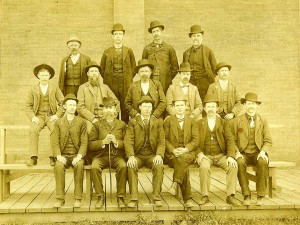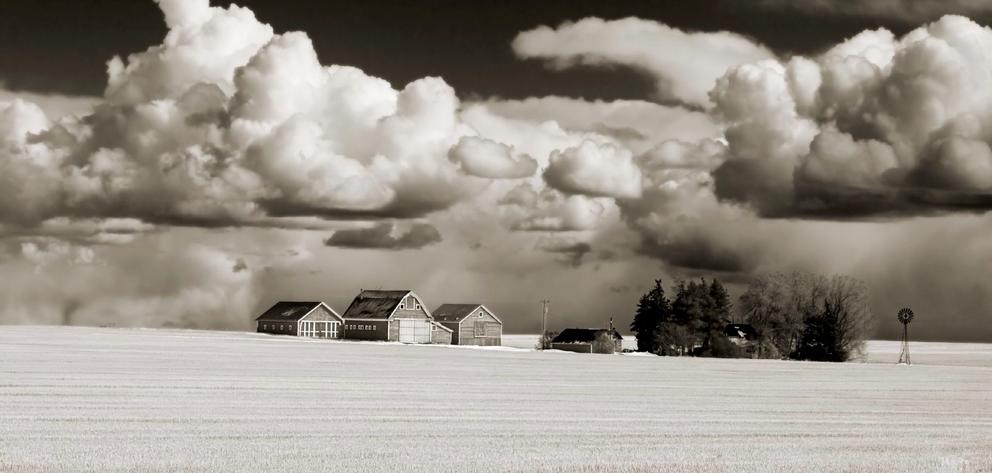Late on the night of July 30, 1894, Charles Gloystein, a farmer in Mica, a small community south of Spokane, disappeared. His wife said the couple had heard knocking and her husband went out onto the porch to investigate. She heard him talking to someone about a wagon. Mrs. Gloystein was tending to a bevy of sick children — they had five between the ages of 9 months and 8 years. She thought nothing was amiss until she found her husband was gone the next morning.
The farmer’s battered straw hat with blood and hair was found 200 yards away, along with a club. Believing foul play occurred, the sheriff and a local posse scoured the countryside. Gloystein had been the target of harassment for his politics. A secretive populist group, including some of his neighbors, became suspects. Very quickly, the search for Gloystein became a search for a body.
The Gloystein case is a forgotten footnote in Washington history, but a story that has resonance in the Trump era when the media is under fire, social media is a force, and the existence of “alternative facts” is asserted. A populist surge of alienated rural Americans and urban workers, a fracturing two-party system, demagoguery and threats of violence, and fake news: We’ve been there before. These are familiar threads of both 2016-17 and the 1890s, when farmer Gloystein vanished.
The conclusion of the mystery sheds startling light on the twists and turns such politics can take in a divided state.
In 1894, populism was on the ascent nationwide. In Washington, a populist rebellion would upend the state’s political establishment, rejecting both the Republican and Democratic parties. Founded in Ellensburg in 1891, the so-called People’s Party made gains in 1892 and displaced Democrats as the major opposition party in Olympia in 1894. The populists met with “immediate and surprising success,” concluded historian Thomas Riddle.
Reform, public ownership of railroads, finding common cause with labor, fiscal responsibility, and anti-Wall Street planks were some of their issues. So too were anti-Asian immigration measures and anti-Semitic attacks on the big bankers.
A stronghold of the rebellion was Eastern Washington. Rural farmers were being dictated to by the railroads and charged outrageous rates to ship grain to the Midwest or Pacific ports. Family farmers were under pressure, and many felt forced to expand and take on debt they didn’t want or couldn’t afford. Many were worried about imminent economic collapse like the survivalist preppers of today — “calamity populists,” some called them. At least one mysterious group emerged and was said to use intimidation to stifle dissent. The Seattle Post-Intelligencer referred to them as the “new Klu [sic] Klux.”
Dissent in southern, rural Spokane County and the Palouse region of adjacent Whitman County consisted of traditional Republicans. Many farmers embraced the new populist cause, but Charles Gloystein, a farmer from the Midwest who came via Oregon and settled near Mica, did not. And he let people know it. In an election that June, Republicans had beaten back a strong Populist challenge for the governorship of neighboring Oregon. Gloystein gloated by posting a sign near California Creek where his neighbors in the Mica area were sure to see it: “Coming events cast their shadows before. Have you heard from Oregon? Hurrah for the Republican party!”
According to newspaper accounts, a cadre of populists responded by hanging Gloystein in effigy from the local schoolhouse, labeled “I am Charles F. Gloystein, a traitor to my farm, to my country, to my God. Hell is my home.” Other intimidating signs and graffiti were posted, including one saying “Death to Traitors.” Images of skull-and-crossbones and a dagger through a heart were scrawled on the schoolhouse’s exterior.
Suspicion for the harassment fell on a fellowship known as the Freeman’s Protective Silver Federation, the local chapter of which had been founded in Pullman earlier that year. It had a reputation as a group of radical, paramilitary populists who were prepared to fight for their cause. A member defended the treatment of Gloystein, telling him, via a letter to a local newspaper, that the Federation would take matters further “unless you shake the dust of Washington off your feet.” The Oregonian reported that local opinion held the Silver Federation responsible for a “reign of terror” that pervaded the area, with “many Republicans not daring to express an opinion, lest they may also be marked for assassination” — like Gloystein.
Hanging someone in effigy could be taken as more than symbolism in the southeastern Washington of that era where the vestige of vigilante “rough justice” was still active. From 1891-1903, there were at least eight lynchings in Eastern Washington, most for alleged murder or rape. Two had just occurred in June 1894 — the month before Gloystein vanished — when a middle-of-the-night mob hanged two prisoners from the balcony of the new Whitman County courthouse in Colfax, about 60 miles due south of Mica. In what was surely a reference to the Gloystein case, the P-I observed that the growth of populism seemed to correlate with the spread of lynchings outside the South: “Out of populism springs the morbid growth of a secret political society who have in this state, as there is little doubt, lynched a political opponent as ruthlessly as the Southern ku-klux do a suspected negro.”
In the press, the missing Gloystein quickly became the “murdered” Gloystein. Newspapers affiliated with the Republican mainstream, which dominated state politics, covered the story with vigor, none more so than the P-I. The paper sent a special correspondent to Spokane County to document the “assassination.” Sheriff Francis “Mac” Pugh, a Spokane Republican who was acquainted with Gloystein, concluded, “The man is dead, beyond all doubt, in my mind, and he was murdered by the Silver Federation, but we can never hope to prove anything unless we can produce a body.”
Despite it being in the middle of harvest, scores of farmers helped in the hunt for the body. Republican Gov. John McGraw offered a $500 reward for Gloystein, dead or alive, and if dead, an additional $500 for the arrest and conviction of his killers. The Spokane county commissioners also offered $1,000.
One theory was the farmer’s corpse had been hauled off in a wagon, others speculated that Gloystein had been stashed in a gulch, river, old well or mine shaft, or hidden in the root cellar of some populist sympathizer. In the meantime, some of the members of the Silver Federation helped with the search, and worried that things looked bad for them.
The casting of the populists as extremists was political red meat for the regional Republican press. The P-I claimed the group was not truly formed to support “free silver” because a prominent group already dedicated to that cause existed in Spokane. Rather, they claimed, it was a resistance movement to the collection of mortgages. Some charged the Federation and populists in general with “anarchism,” and showing disrespect for the law. Comparisons to the Klan referred to harassment, kidnapping, night raids and secrecy.

The P-I’s correspondent gathered from mostly anonymous informants a sense of the level of intimidation people felt in and around Mica. One said of the Silver Federation, “They’re just like a lot of coyotes. They all howl alike … I can spot a calamity Populist by the sound of his wail just the same as I can tell a coyote in the night when I hear his voice. O’ course, they are strong in numbers just now, and we can’t do much talking or they’ll treat us as they’ve treated Charley Gloystein.” The paper said, “It is reported that several leaders in the federation have declared repeatedly: ‘If we can’t win by the ballot we will by the shotgun!’” Newspapers throughout the West reported on the “kidnapping and murder” of Gloystein. The Spokane Spokesman-Review said the perpetrators deserved the scaffold.
While newspapers ran with the murder theory, others weren’t so sure. They included one of the Federation’s members, a Gloystein neighbor and harasser, A.C. Rubeck, who was one of those who had hung the farmer in effigy. “Rubeck says he must have run away,” said Gloystein’s wife, “but he didn’t, he couldn’t; he had no cause to leave.”
For weeks, the mystery lingered.
Until the case was solved in late September when Sheriff Pugh returned from a trip to a ranch outside Moro, in Sherman County, Oregon, not far south of the Columbia River. There Pugh found Charles Gloystein hitching a team to a hay wagon. “Charley, is that you?” the sheriff cried upon encountering his man. Gloystein admitted that it was and burst into tears. Pugh was following a lead that Gloystein was alive and living under the name of Charles Slawser.
Turned out, the supposedly murdered man had set up his disappearance to look like a kidnapping or murder. In fact Gloystein had simply deserted his wife, family and farm. He admitted to the sheriff that he had staged the dropped straw hat with his blood. He had hoofed it across country to Colfax, shaved his mustache and caught a freight train to The Dalles. He said he did it to flee populist intimidation, but most suspected he was just running out on his family. His wife, papers reported, wanted her runaway husband back yet Gloystein was reluctant to return.
Had the whole thing been a case of abandonment? The missing farmer claimed to have regretted the hoax almost immediately and all the pain it caused for family and those falsely suspected. The sheriff reportedly scolded, “Charley Gloystein, if you ever desert your family again I will hound you to the end of the earth.” Still, it was determined he had committed no actual crime.
The P-I had boldly touted the murder on its front page and spent almost two months pushing a story that was a hoax. It now meekly reported the truth in a short item buried inside the paper under the headline, “Gloystein Not Dead.” The story that had been followed avidly by the region’s newspapers fizzled with a kind of lame, “Oh, never mind.” The big populist conspiracy of anarchism and Klan-like violence had been mostly fevered speculation reported as fact, and political theater played out through a willing media that found a convenient, compelling storyline, until the truth got in the way. Sympathy for Gloystein evaporated.
So did interest in his fate. There was not much follow-up, but partisan wags poked fun at the expense of Republicans for having created hysteria based on a fraud. The Islander newspaper in the San Juan Islands commented on the discovery of the hoax by indicating the word “Gloystein” had caused the local GOP official to “tumble off his chair in a fit,” and that another “ran out doors, swung his arms around, and jumped up and cracked his heels together twice and shouted, ‘he ought to be killed,’” concluding that “after this burst of eloquence nothing more was said about Gloystein.” The one-time martyr was now an unmentionable whose unfortunate non-murder was a political and journalistic embarrassment. For Republicans, it would have been better if he had been killed. Still, they held onto power in Olympia during that year’s election.
As for the state’s populists, the publicity didn’t hurt at all. In 1896, they took over Washington state’s government — from the governorship on down. The populist political realignment didn’t last long, but it helped reshape both major parties, if not the state’s longstanding East-West divide. The Gloystein hoax, however, is worth remembering as examples of what can happen in fevered times: a tendency to jump to conclusions and a willingness to exploit people’s fears to advance an agenda.



